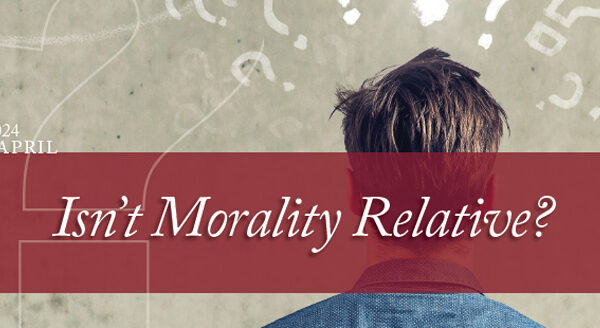Back to series


Open in prayer — that through this study God would guide your discussion and equip you to become more effective in defending and sharing your faith in Jesus Christ.
Conversations That Count, Amy Orr-Ewing (43 min.).
Discuss the topic “Conversations That Count” using these starter discussion questions:
1. What are some of the cultural pressures that keep us from getting into “conversations that count”?
2. How can we overcome these barriers and begin to have conversations about faith?
3. What are some insights from Amy’s talk that might be helpful in sharing our faith more boldly through conversation?
4. What did you learn from Mary Gardner’s article on ways to talk about your faith?
Read the conversational apologetics exercise (see homework, Session 1). Break up into small groups to complete the exercise.
Determine practical steps to take this week to apply what you’ve discussed. Take a few minutes to write them down.
Pray for one another and your non-Christian friends.
Introduce the assignments for the next session and close in prayer.
Assignments to Complete before Session 3: Why Trust the Bible?
Memorize and meditate upon 2 Timothy 3:16–17 (NIV):
All Scripture is God-breathed and is useful for teaching, rebuking, correcting and training in righteousness, so that the servant of God may be thoroughly equipped for every good work.
Read the article “Is the Bible Trustworthy and Reliable?” by Patty Houser. (This article is included below.)
Read and reflect upon the following conversational apologetics practice exercise, to be completed and discussed in Session 3.
Conversational apologetics exercise: Reflect upon the critiques and criticisms that you’ve heard about the Bible. Begin making a list of them in preparation for Session 3. At the meeting, share your list with your group and come up with a combined list of critiques or attacks upon the authority of the Bible.
Pick one or two of those critiques and put it into an everyday conversation that you might have with a friend or colleague. Brainstorm a variety of approaches to addressing the critique in a thoughtful and loving manner.
Then act out the scenario in conversational pairs in which someone critiques the Bible and you respond to the critique. Remember that it may be best to ask the person questions about her critique rather than just preach at her. Then reverse roles.
Is the Bible Trustworthy and Reliable?
by Patty Houser, M.A.
Although it is impossible to obtain exact numbers, there is little doubt but that the Bible is the world’s best-selling and most widely distributed book of all time. It is estimated that more than 5 billion copies have been printed. Despite its notoriety, many people think it is just one big book written a long time ago.
In reality it is a collection of sixty-six books written by forty different authors in three different languages (Hebrew, Aramaic, and Greek) on three different continents (Africa, Asia, and Europe) over some fifteen hundred years. The unity of the Bible’s core themes despite this diversity of authorship, language, and location is one reason Christians hold it in the highest regard as the authoritative and inspired Word of God. They believe that the Bible is God’s special revelation to mankind about His plan of salvation for the world through Jesus Christ. The Scriptures are “alive and active. Sharper than a double-edge sword” (Heb. 4:12 NIV) and are profitable for “teaching, rebuking, correcting, and training in righteousness” (2 Tim. 3:16 NIV). Christians around the world believe that the Bible is the authority and guide for all things pertaining to life and faith.
However, outside the church, it is a different story. When the Bible is placed next to other holy books, it is sometimes singled out and accused of being inaccurate, contradictory, mythical, intolerant, bigoted, chauvinistic, and homophobic. Charges are levied against the Gospels, in particular. For example, some naturalists (those who do not believe in the possibility of the supernatural) argue that Christians and the Gospel writers over time ascribed supernatural qualities to Jesus as the story was told and retold and modified along the way. They argue that any educated person wouldn’t put credence in the miracle stories; Christians shouldn’t read the Bible as absolute truth, rather, they should read it as one would read any other myth.
But are these accusations true? Are there errors in the biblical text? Were Jesus’s miracles added to the text hundreds of years later when the text was copied and recopied by the scribes, making them unreliable?
Here I will present evidence that points to a wealth of manuscript, archaeological, prophetic, and statistical support for the idea that the biblical texts of the Old and New Testament are trustworthy and reliable.

Manuscript Support:
Number of Manuscripts
One criterion for determining the authenticity of an ancient literary work is to examine how many manuscript copies of the original document still exist today. A larger number of manuscripts gives us more hard evidence to help establish the authenticity of the original text as we compare the differences and likenesses of these copies. So how many manuscripts of the Gospels are in existence today?
Before looking at the exact number, two features about the manuscripts must be understood. (1) The original documents or autographs of the New Testament no longer exist. What does exist, however, are copies of the original documents called the extant manuscripts. (2) The authors wrote the New Testament on papyrus. To make papyrus, reeds were split, pressed, and glued together into sheets and then tied together to form scrolls. Because papyrus was brittle, many of the scrolls broke into pieces so that what we have today are pieces of the copies in varying sizes. So when we talk about counting the number of manuscripts, the number reflects the copies of the original documents either in their entirety (in the rare case they exist) or pieces of it, in varying sizes.
How many manuscripts of the New Testament still exist today? A lot! Nearly 24,000. There are more than 5,800 Greek manuscripts and more than 10,000 of the Latin Vulgate. In contrast, Homer’s Iliad has some 1,900 copies, Tacitus’s Annals, 36 copies, Caesar’s Gallic Wars, 251 copies, and Plato’s Tetralogies, 238 copies1. This means that the New Testament has approximately 22,000 more copies than its closest contender, which is interesting, given that Homer’s Iliad is never challenged and is taught in our public schools as an authentic and reliable piece of work.
Time Lapse between Originals and Earliest Copies
The next factor to consider when examining the manuscript support is the time lapse between the date of the original work and the date of the earliest surviving copies. The idea is that the smaller the gap, the less likely it is that myth or legend crept into the text over the years due to the scribes altering them when they made the copies. What is the time lapse between the date of original texts of the Gospels and the date of their earliest surviving manuscripts? It is narrow.
Most scholars agree that the New Testament was written between AD 40 and AD 100. However, some scholars have good reasons to believe that John’s Gospel was written between AD 60 and AD 90. The earliest surviving manuscript of the Gospel of John is the John Rylands manuscript and is dated between AD 117 and 138.2 This means that the gap between the original manuscript of John’s Gospel and its earliest surviving manuscript, is only fifty years. Another early manuscript, the Bodmer Papyri of John, is dated to AD 200, making the time difference just a hundred years.3
In contrast, the time intervals between other well-accepted works of antiquity are much wider. For instance, the time gap for Homer’s Iliad is four hundred years, and the time gap for Tacitus’s Annals, Caesar’s Gallic Wars, and Plato’s Tetralogies is a thousand years.4 This means that the Gospels beat their next contender by almost two hundred years and the others by six hundred. Yet again, these classic Greek works are never challenged, while the Gospels are consistently on trial.
Accuracy of Copies
Another factor to consider is the accuracy of the copies. Are the Gospels full of errors and contradictions? Although scholars of textual criticism say that there are more than 200,000 variant readings in the surviving manuscripts, this number is grossly inflated due to an odd counting procedure. And what is that? It is this: If a word was misspelled in 3,000 manuscripts, then the misspelled word is counted as 3,000 variants, instead of just one. This makes it look like the Gospels have thousands of mistakes, when they do not.5 How many variants do the manuscripts really have? There are only a few manuscript variants in the Gospels.
There are 20,000 lines in the New Testament. Only forty lines are in question. This means that 99.5 percent of the material in the New Testament is accurate and trustworthy. Does this mean that the remaining forty lines (or .5%) have significant errors? No, it does not. One-eighth of the variants are things like missing letters in a word or misspelled or transposed words. This means that only fifty or one-sixteenth of the remaining one-half percent of variants are really in question as to the original text. However, it’s important to note that not one of these variants affects Christian doctrine.
In contrast, there are 15,600 lines in Homer’s Iliad. Seven hundred and sixty-four of them are in question, which means that Homer’s Iliad has ten times more variants than the New Testament, even though it’s only three-quarters of the length.6

Archaeological Support
To determine if the Gospels are historically accurate, we need to look at the archaeological support. Fortunately, there are many cases in which archaeology has confirmed the biblical record.
For instance, a stone with the inscription “Pontius Pilate Prefect of Judea” was discovered in 1961, dating back to AD 16–37, which implies that Pontius Pilate existed during Jesus’s lifetime, as the Gospels claim (Matt. 27:2; Mark 15:1–15; Luke 23:1–5; John 18:38). 7
Archaeological discoveries have also given us insight into the form of Jesus’s death by crucifixion. The remains of a male in his twenties who was crucified in the middle of the first century was discovered in 1968, verifying that the Romans in Israel used crucifixion to execute criminals, just as the Gospels claim (Matt. 27:45–56; Mark 15:33–41; Luke 23:24–49; John 19:28–37).8 There are many more archaeological discoveries that verify the historicity of the Gospels.
Prophetic Support
To establish the veracity of some of the Gospels’ more remarkable claims, especially those that argue that Jesus is the long-awaited Jewish Messiah and the Savior of the world, the prophecies of the Hebrew Scriptures as fulfilled in the New Testament should be examined. Most scholars agree that the Old Testament was written over a thousand-year period and has more than three hundred prophecies about the Jewish Messiah. Most Orthodox Jews believe that these prophecies were written so that the people of Israel could correctly identify the Jewish Messiah and Savior of the world when He came, because only the true Messiah would be able to fulfill them, and thus prove His identity.
The Gospels claim that Jesus fulfilled all of the more than three hundred prophecies about the coming Messiah. Matthew and Luke said that Jesus was born of the virgin Mary, a young woman who had never had sexual intercourse with a man, which fulfilled the prophecy found in Isaiah 7:14. Matthew, Luke, and John affirm that Jesus was born in Bethlehem just as the prophet prophesied in Micah 5:2. Matthew, Mark, and John establish that Jesus had a ministry of miracles, as prophesied in Isaiah 35:5, 6a; 32:3–4. And both Matthew and Mark wrote that Jesus would be crucified with thieves just as Isaiah said He would in Isaiah 53:12.
Some have raised the question, could the disciples have changed the Old Testament text to make it look as if Jesus fulfilled the Old Testament prophecies by the events of His life and then written about it in their Gospels to deceive readers?
This question is quickly refuted, as both archaeology and textual criticism have provided evidence that demonstrates that the canon of the Hebrew Scriptures was firmly in place hundreds of years before the Jesus’s apostles and the evangelists even lived. Most scholars agree that the Old Testament was all written by 450 BC. And thanks to the remarkable archaeological discovery of the Dead Sea Scrolls, a near-perfect manuscript of the book of Isaiah, which contains many of the messianic prophecies, was found in the collection. Scholars across the ideological spectrum date the manuscript between 335–324 BC and 202–107 BC. When Archer Gleason, a well-known scholar of textual criticism, compared it to the book of Isaiah in the Bibles printed today, he said that it “proved to be word-for-word identical with our standard Hebrew Bible in more than 95 percent of the text. The 5 percent of variation consisted chiefly of obvious slips of the pen and variations in spelling.”9 Therefore, the apostles could not have altered the prophecies written in the Old Testament text.
Statistical Support

To authenticate the Gospels’ most audacious claim—that the Bible is a supernatural book written by God—we need to look at the statistical support. To substantiate this claim, we need to ask, How likely is it for just one person to fulfill all the Old Testament prophecies? If it is statistically likely, then many people in history could have fulfilled the Old Testament prophecies and been in the running for the Jewish Messiah and Savior of the world. This would mean that anyone could have authored the Bible and made the predictions. However, if the probability is extremely low, this would point to the idea that God Himself wrote the Bible. Why? Because no human being has ever been able to predict the future with 100 percent accuracy, as the author of the Bible apparently did. The only One who could have done that is God. Therefore, how likely is it for one person to fulfill all 334 Old Testament prophecies? It is statistically impossible.
The probability of fulfilling only eight prophecies is 1 x 1017 or 1 in 100,000,000,000,000,000. To comprehend how unlikely this is, imagine laying silver dollars on the state of Texas two feet deep, marking one of them, and then mixing them together. Next, imagine trying to find the marked silver dollar when blindfolded. How likely is it that the right one would be picked? It would be extremely unlikely. And this is the probability of fulfilling only eight prophecies.
The probability of fulfilling forty-eight prophecies is 1 x 10157. To visualize this, imagine laying electrons down in single file for an inch, marking one of them, mixing it in with the others, and then retrieving it while blindfolded. Again, how likely would such a feat be? To answer “not very” is an understatement. While such a task doesn’t appear difficult at face value, for most humans don’t know how tiny an electron is, physicists say that if a person tried to count the electrons in this one-inch line, it would take 19 million years to count them, and that’s only if they were counted at a steady pace of 250 per minute. Thinking of the probability in this way shows how totally unlikely the statistical probability of it happening really is. Again, Jesus did not fulfill just eight prophecies or even forty-eight prophecies. Jesus fulfilled 332. And that He did could only have been first predicted and next orchestrated and fulfilled by God.
In his book The New Testament Documents: Are They Reliable?, world-renowned scholar F.F. Bruce made these comments, “Christianity has its roots in history… This historical once-for-allness of Christianity… makes the reliability of the writings which purport to record this revelation a question of first-rate importance.”
After examining the manuscript, archaeological, prophetic, and statistical evidence, one can see good reasons to answer affirmatively the question of the reliability of the Bible. The Bible is reliable and is God’s Word, one of His means of revealing His nature and plan for salvation to the world.
This presentation has been developed into a special edition of Broadcast Talks. To read about Is Christianity Oppressive or Liberating for Women?, please click here.
« INTRO 1 2 3 4 5 6 7 APPENDIX »

Notes:
1 Josh McDowell and Sean McDowell. Evidence That Demands a Verdict: Life-Changing Truth for a Skeptical World, rev. ed. (Nashville: Thomas Nelson, 2017), 55–60.
2 Ken Samples, A World of Difference: Putting Christian Truth-Claims to the Worldview Test (Grand Rapids: Baker Books, 2007), 93.
3 Ibid., 93.
4 McDowell and McDowell, Evidence That Demands a Verdict, 55–60
5 Norman L. Geisler and William E. Nix, A General Introduction to the Bible (Chicago: Moody Press, 1986), 468.
6 McDowell and McDowell, Evidence That Demands a Verdict, 55–60.
7 McDowell and McDowell, Evidence That Demands a Verdict, 55–60.
8 John D. Currid. Ten Most Significant Discoveries. Article in The ESV Archaeological Study Bible. (Wheaton: Crossway, 2018), p. xxii.
9 Archer Gleason, as cited in Geisler and Nix, A General Introduction to the Bible, 367.
10 F.F. Bruce, The New Testament Documents: Are They Reliable? (Downers Grove, IL: InterVarsity, 1964), 7–8.

Patty Houser (MA Christian Apologetics, Biola University) has served as the Director of Women’s Ministries for Solid Reasons, is a national conference speaker and teacher who equips women to share and defend their faith in language women best understand woman to woman. She lives with her husband and son in Burke, Virginia.

Amy Orr-Ewing
Speaker Amy Orr-Ewing is an international author, speaker, and theologian. She presently serves as the Director of Programs for the Oxford Centre for Christian Apologetics (OCCA). She has written two books exploring key questions in apologetics: Why Trust the Bible? and But Is It Real? She has coauthored several books with her husband Frog, including Millennials: Reaching and Releasing the Rising Generation and Holy Warriors: A Fresh Look at the Face of Extreme Islam. Amy has also contributed to publications such as God and the Generations and Worth Knowing: Wisdom for Women. She has been invited to speak in the White House, Capitol Hill, and the UK Parliament. Amy holds a Ph.D. in Theology from the University of Oxford. COPYRIGHT: This publication is published by C.S. Lewis Institute; 8001 Braddock Road, Suite 301; Springfield, VA 22151. Portions of the publication may be reproduced for noncommercial, local church or ministry use without prior permission. Electronic copies of the PDF files may be duplicated and transmitted via e-mail for personal and church use. Articles may not be modified without prior written permission of the Institute. For questions, contact the Institute: 703.914.5602 or email us.
COPYRIGHT: This publication is published by C.S. Lewis Institute; 8001 Braddock Road, Suite 301; Springfield, VA 22151. Portions of the publication may be reproduced for noncommercial, local church or ministry use without prior permission. Electronic copies of the PDF files may be duplicated and transmitted via e-mail for personal and church use. Articles may not be modified without prior written permission of the Institute. For questions, contact the Institute: 703.914.5602 or email us.
-
Recent Podcasts
A Welcome Change in Apologetics
by Randy Newman, Aimee Riegert on April 19, 2024We’re burdened for our friends who don’t know...Read More
-
Questions That Matter Podcast – Samuel James and Digital Liturgies
by Samuel James, Randy Newman on April 19, 2024
-
The Side B Stories – Dr. James Tour’s story
by Jana Harmon, James Tour on April 12, 2024
-
Recent Publications
Isn’t Morality Relative?
by Christopher L. Reese on April 1, 2024It is widely accepted in the Western world...Read More
-
Do Muslims and Christians Worship the Same God?
by Andy Bannister on March 1, 2024
-
Artificial Intelligence and Its Impacts on Humanity
by John Lennox on February 13, 2024
0
All Booked
0.00
All Booked
0.00
All Booked
22140
GLOBAL EVENT: Keeping the Faith From One Generation To Another with Stuart McAllister and Cameron McAllister, 8:00PM ET
https://www.cslewisinstitute.org/?event=global-event-keeping-the-faith-from-one-generation-to-another-with-stuart-mcallister-and-cameron-mcallister-800pm-et&event_date=2024-05-17®=1
https://www.paypal.com/cgi-bin/webscr
2024-05-17

Next coming event
Days
Hours
Minutes
Seconds
GLOBAL EVENT: Keeping the Faith From One Generation To Another with Stuart McAllister and Cameron McAllister, 8:00PM ET
On May 17, 2024 at 8:00 pmCategories
Speakers

Amy Orr-Ewing
Speaker
Team Members






